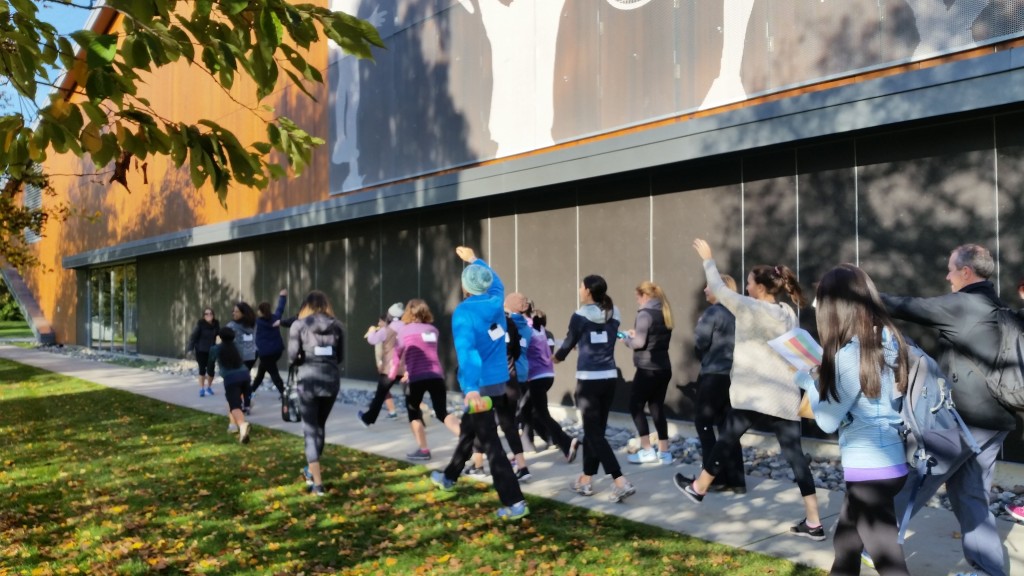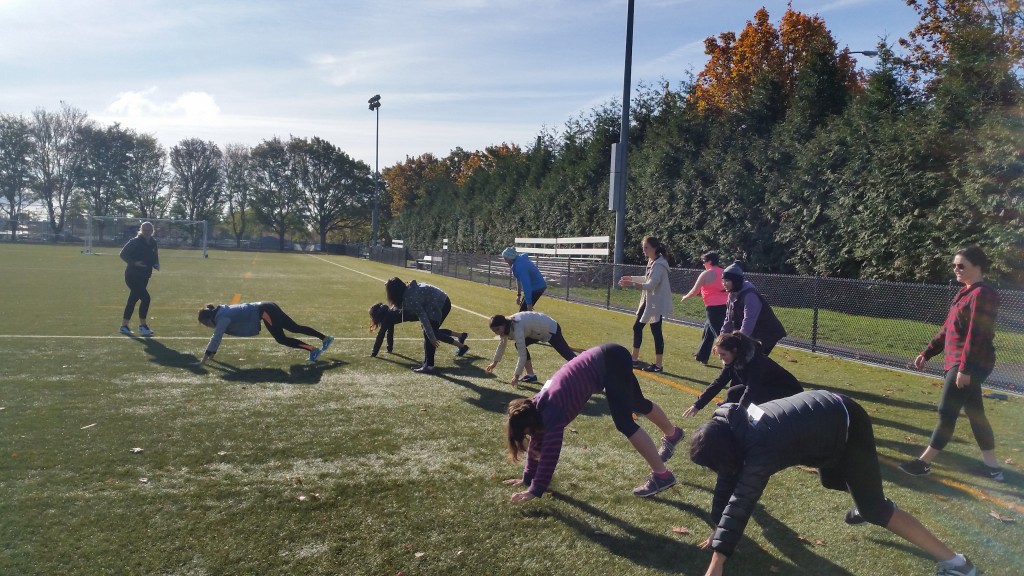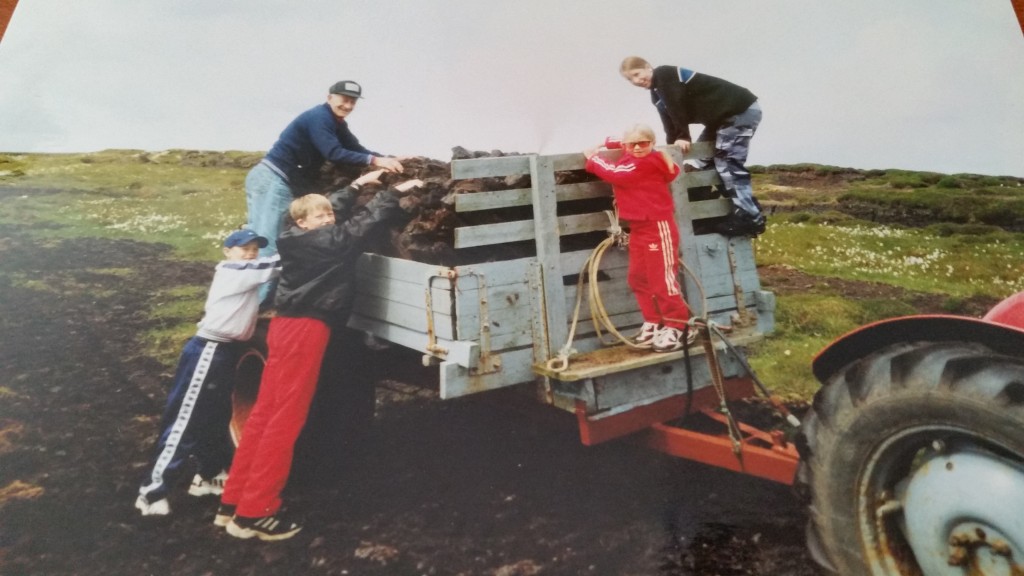It was our last group teach for PE last Friday. I thought the group did an amazing job on teaching health and physical literacy. The instant activity of spelling out letters was fun and gave us the opportunity to be creative (I love the CITE photo Steve took). I was in Cheryl’s group for reading discussion; the summary was clear and concise, which gave us the chance to reflect more for discussion. I learned new information and strategies for facilitating health and physical activities into other subjects and I had fun listening to other people share their experiences. The warm up and the cool down were awesome; I can imagine grade 2-3 students would be really engaged with acting out as wild animals in the jungle. Also, this is a great activity to do a cross curriculum with a drama class! I loved the main activity and I was able to get to 13 out of the 16 stations. We all had so much fun; they must have spent a lot of time preparing for all those stations and setting up. I like how they connected different subjects to the activities at different stations, such as art, music, English and health. This last PE lesson was a great demonstration of how to do cross curriculum with PE and other subjects and it was very well taught!
Tag Archives: movement journal
movement journal – week 8
The two group teaching teams from last class did very well. I like how the gymnastic team included Halloween theme into their activities, and I thought it was very neat. As well, I thought the four stations were broken down nicely, and giving the instructions while we were all at the middle instead of explaining it four times at each station was very smart. As for the summary and discussion, our discussion in terms of how to create a safe and inclusive environment was rich and helpful for the practicum. For the dance team, I liked the warm up activity where we had to act like eggs, chickens and dinosaurs. It was fun playing and watching other people, and I think they did a great job using the scaffolding technique. In addition, I loved how they not only taught us certain moves but also gave us the freedom to create dances close to the end of their lesson. All presenters from both groups were enthusiastic and have clear, loud voices! Good job girls, I loved it! 🙂
Tiffany’s Movement Journal_ Week 9 (Nov 18)
This week’s reading summary was particularly interesting to me – in modern society, so many things are taken for granted and normalized, that certain topics such as diversity can so easily be overlooked in the PE classroom. Notions such as “Bob can’t participate in class today because the activities involve running and he is in a wheelchair” or “Liam is a strong and healthy 17-year-old male Caucasian student, he should be on the football team” are so ingrained into our culture that we rarely stop and critically assess them.
I still remember experiences from school, when boys were expected to play soccer outside and girls were expected to participate in quiet activities, when a Sikh boy couldn’t participate in roller blading because the helmets didn’t fit over his turban, when a boy with a physical handicap never participated in our PE classes. I recall recognizing the injustice of the situations, but never stopping to think about or address the issues.
Throughout the week, diversity seemed to be a common discussion in our classes. Racism, gender biases, stereotyping – these are just a few of the epidemics that have taken over society. These epidemics are not spreading through loud or visible means however. They are silent killers, deeming us mute and seemingly ignorant of the discrimination and segregation happening all around us.
In all of our class discussions, the solution spiraled down to something fairly simple – awareness. Simply by speaking out loud about an issue, or educating people so they could learn more about something that was previously ambiguous, can bring topics out of the darkness and demystify and de-normalize them. Yesterday, Sheena did a wonderful job of leading our group discussion and helping us to identify what we should be aware of (in regards to diversity) as educators. I hope that as a cohort, we can continue to question and build on each other’s thoughts and ideas, and push each other forward on this amazing learning journey!
Movement Journal- Week 6
Lexi, Brianna, Katy and Jackie did very well today for outdoor education. Their instant activity “Cite Possible” was very interesting and informative. We got to move around, interact with strangers and explore nature. I was in Katy’s group during discussion, and she led the summary and discussion very well. Instead of giving us a lot of information once, she used many questions to keep our attention and stimulate us to think about the textbook content. For the main activity, I loved all four stations. Katy’s lesson on Air was helpful; I learned about many properties or air which would usually ignore or take for granted. In Lexi and Brianna’s stations, we learned about the importance of team work and supporting each other. Finally, Jackie’s station was fun and meaningful, and it was clever how she tied it in with the aboriginal content. Making art with leaves, wood, and other objects from nature can be adapted in both primary and intermediate classrooms, either in art, PE or even science classes. Overall, I think the class today was very well done and helpful, and I will definitely use some of the lessons they taught in my practicum. Good job ladies! 🙂
Movement Journal – Michelle Parker
One thing I reflected on this week was how PE was taught in my practicum school. This past week I was able to see two different PE classes with two different teachers. Interestingly, both classes played some form of dodgeball. The grade 7 class played a variation of dodgeball called partner dodgeball where they were taking turns hitting their partner. The grade 3 class played “skittles” a game where they had to hit down pins in the back of the opposite territory. Then they played the version of dodgeball where once a student is hit they go to the opposite side and have to hit someone on the opposite team to get back into the game. It is interesting to see so much of a hall of shame game being played in the classroom.
The result of this really made me think about how I would plan a PE lesson. I think my first PE lesson will be one with a variety of activities and one that is inclusive for all students. As I get to know the students I can learn what they enjoy doing and plan inclusive games around their interests.
We looked at alternative environments for lessons. My school is located within a residential area so walking to other environments is limited. However, they have a huge grass field in the back. There is a lot of space to set up fun amazing race, obstacle course type games. Some of the activities we did in this week’s class would work really well in this environment.
Tiffany’s Movement Journal_Post Lesson Reflection (Oct 14)
This was my first “practice teach”, and I must say it was a great learning experience. The first thing that struck me was the energy that was generated just by being outside – we were blessed with beautiful sunshine, the fresh air was invigorating, and Meghan’s enthusiasm was contagious! Even though our class was nothing fancy – we didn’t go on a paddleboarding field trip, or go on a hike up at Grouse Mountain – merely being outdoors had a positive impact on our physical and mental well-being.
One thing that I learned from this group teach was the importance of clear, written communication. I can be a bit of an “organization freak”, and throughout the process of planning our lesson, I color coded and made charts to my heart’s content. Our group discussed all of the logistics and felt ready to go. After the lesson however, Steve pointed something out that none of us realized – even though we had discussed and expressed everything in our group teach, not everything was documented in our lesson plan. We did not realize the importance of written communication – if “something” is not written down, those who were not part of our discussions would never know that that “something” ever existed. What if, as a future educator, I was sick and couldn’t deliver the lesson I had planned? What if I did not write my lesson plan clearly, resulting in making the life of my TOC extremely difficult? What if I did not outline the safety precautions properly on the field trip forms, and a student got hurt as a result? As professionals, we must remember that we are being held accountable for all of our actions, so we have to act as diligently and responsibly as we can!
Lastly, I want to take this time to thank the class for all of your enthusiasm and participation! Without it, our lesson would never have been able to take form. Thanks for giving us such a wonderful learning experience : )
Outdoor Education – Jenny Cho’s Reflection
Well done Brianna, Jackie, Katy and Lexi! It was a nice change of environment to be outside. I really enjoyed the instant activity. It reminded me of the amazing race. Our cohort is energetic so it was nice to have the chance to run around outside!
This week we are learning about Outdoor Education and how we should incorporate our environment and setting in our lesson plan. I have always thought outdoor education was like going on a tour or a field trip. But that isn’t the case. We can take indoor activity and played them outside. This is great in many ways. Most students enjoy being placed in a different setting, we love being in the sun when it is sunny and most importantly, it gives students ideas how to play outside while teaching physical literacy. For example, passing a balloon teaches a lot. We had to work as a team, we had to think of a strategy and also, manage our strength so we won’t pop the balloon. It was a lot of fun.
I liked the discussion question Lexi proposed to our group in regards to the characteristic of our own PE teacher. I had a really great connection with my PE teachers and they are my role model. I would not be where I am right now without them. I can only hope I can do the same to my future students.
Week 6 Outdoor PE Reflection
This week’s outdoor ed focus was a really great experience. I was surprised by the completely different feel it gave to the lesson. Being outside was also really energizing, and I felt engaged with the UBC community. I also felt connected to the locale, seeing the ocean off in the distance, learning about the upside-down tree, and seeing other landmarks of UBC I hadn’t viewed yet. I imagine that students would also have this positive experience, were they to engage in PE class outdoors in their communities.
I appreciate how Outdoor Ed nicely connects to the Aboriginal Ways of Knowing by focusing on a sense of place. Being outside also supports the wellbeing of the self, the community and the land. Western education doesn’t often make enough space for children to be outside, which is so important to health. For example, getting vitamin D from being outside has important implications for serious health issues like depression and hormonal regulation. Being outside can connect us to the wider community, and knowing the outdoors fosters a sense of place. I am really excited to incorporate the outdoor element of PE into my future practice.
Gemma’s Movement Journal – October 14th
Being part of the BEd program has provided me with a lot of new experiences, although I think being a hedgehog and a polar bear are an absolute first for me! But the lesson on Wednesday was fun and engaging, and we managed to work up a sweat while we were at it. So great job ladies!


I love doing and planning scavenger hunts (I’ve done a few for birthdays & bachelorette parties), but I also think they are an ideal activity for encouraging students to experience the outdoors. There is a healthy dose of competition, and allows for students to practice their thinking, creative and team-working skills, as well as encouraging them to experience new things. In thinking about my own experience growing up, we very rarely experienced outdoor education or alternate environments for either P.E. or regular classes… I only remember one occasion of going outside to a nearby field in the last week of the year as a treat (although this may have something to do with the horrendous Scottish weather!). It was still a time where we spent a lot of time playing outdoors outside of school and I was lucky enough to come from a family who came from more rural communities and who enjoyed this. We would spend every summer up in the islands, playing on tractors and in the moors helping to collect peat.
So it’s scary when just 20 years later, the majority of play occurs indoors. I remember going out for dinner a month or two ago and seeing a family sitting nearby and all three of the kids were straight away sitting on their devices playing games. We are so lucky to be living in British Columbia where there is nearby access to so many varied environments. Yesterday it was a 5-10 minute walk until we were in the middle of a forest. We could have gone 10 minutes in the opposite direction and been at Wreck Beach. So as educators we really need to instill this outdoor mindset from the start. I saw a couple of videos on Youtube of teenage gamers and the impact on their social skills and their understanding of society is clearly evident. I know Steve mentioned this in class previously, but the David Suzuki Foundation has some really great resources and ideas for implementing an outdoor mindset within the classroom, and this is something I will definitely be incorporating if I’m lucky enough to have my own classroom one day. It even has some benefits for teachers too… (http://www.davidsuzuki.org/blogs/science-matters/2014/09/learning-in-nature-is-good-for-teachers-and-students/)
Oct 7 Movement Journal – Sydney
Having done the reading summary for last class, I was able to familiarize myself with the various models associated with teaching Physical Education. I myself liked the Teaching Games for Understanding the most as I really liked the aspect of skills learned in one game being carried over into other games and sports. I also liked how drills are not a part of this model since skills should be developed in context as opposed to in isolation. I remember doing drills in elementary school PE and being so bored as well as not understanding the important concepts and strategies behind the game. I feel like the initial modified game also takes some of the pressure off of students because the game feels less formal than the complex, actual game/sport that some students may already know and excel in.
I think the majority of my high school PE classes followed the Multi-Activity Model with the seasonal sport aspect. I never really liked the seasonal sports except for volleyball and we were stuck doing the same sport for a long chunk of time. I feel like the net sports that involved a net in the middle of the gym, like badminton and volleyball were done out of convenience since our teacher did not want to dismantle and then re set up the net, but the other seasonal ball sports could have easily been swapped for something else given that our amount of time with each sport was long and repetitive over the years.

